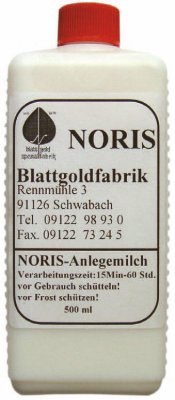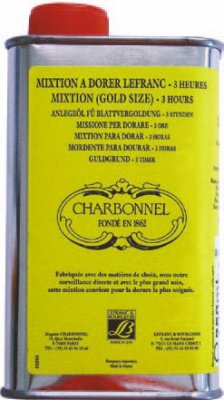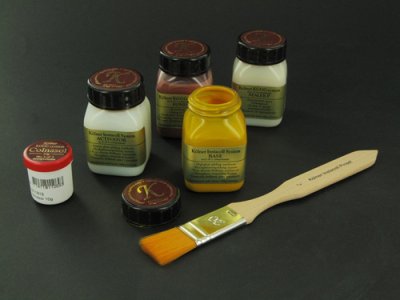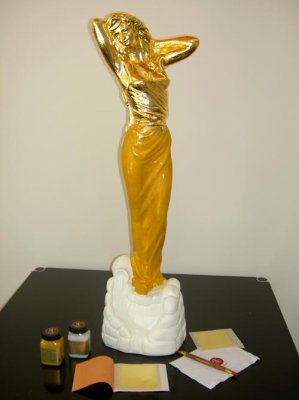Gilding Techniques
Gilding is a technique that consists of applying a certain thickness of gold on another support such as metal, leather, wood or marble in order to sublimate art objets. Gold is considered one of the purest and most precious metals due to its many properties such as its resistance to oxidation. There are different types of products that allow the application of gold leaves, and therefore there are different methods to achieve gilding. We present here the four main methods: water-based gilding, application milk, mixtion and Kölner products.
Water-based gilding
Water gilding, also known as tempera gilding, is a gilding technique mainly used on wood. Dating back to Antiquity, this traditional technique is the oldest and the one that gives the best results, whether the gold used is real or not. The technique of water-based gilding cannot be practiced without prior training because it involves the application of successive layers of different products. Due to its complexity, this technique implies a longer and more precise work that must be carried out without error in order to obtain an optimal result. It requires the use of loose gold leaf and products such as rabbit skin glue, chalk, and various pigments. This technique allows the polishing of the surface to be gilded with agate stone, giving it a much appreciated glossy finish.
This method requires various steps such as the application of gesso (which forms the basis of the gilding), the application of the plate (which consists of preparing the support in order to optimize the application of the leaf when it is moistened with water), the application of the gold leaf, the matting (light layer of skin glue) and the finishing (browning and varnishing action thanks to the agate stone, which allows the option of a glossy result). This technique is not recommended for outdoor gilding. This technique has been used for example in l'Opéra Garnier in Paris.
Click here to buy our gold leaves
Application milk
This technique is easier than the water-based gilding technique. It is quite simple, requiring only an application of the milk with a brush and 15 to 30 minutes drying time. Beforehand, the surface needs to be cleaned carefully and non absorbent. It can be used either on loose or transfer gold leaf. The finish is mat, and it is the cheapest option, even though the results are not very hard-wearing. It is supposed to be used on item which are not daily handled.

Mixtion or gold size
Mixtion technique, which consists of a greasy varnish, is the second major method of gilding with oil. When the mix is applied, it allows the gold leaf to adhere to the substrate. The adhesion time of the mixtion varies according to the type of mixtion used, from a few to several hours. This technique is faster than water gilding, but still requires several steps: the preparation of the surface, the application of a mixture, the application of gold leaf and the varnishing.
This technique is used to gild various supports such as metals, woods, and glass or ceramic objects. Mixtion is mainly used outdoors, although this technique is frequently chosen indoors for woodwork or ceiling decorations. This technique is not as prestigious as water gilding, but its resistance is greater, which allows it to be used outdoors and on supports such as roofs.
As the mix can be used with free or transferts gold leaf, these kinds of products dry within 3 or 12 hours, depending on the product chosen. After a few cases of lead poisoning, it acquired a bad reputation. The ingredient concerned has been removed from the composition of the product, which initially led to a reduction in the quality of the product. Currently, its quality is satisfactory, as the product's formula has evolved over time. The main advantage of this technique is that it allows the finest possible adhesive layer under the gold. This reduces the risk of seeing brush or fingerprints. The rendering is therefore sharper and matte.
The choice of 3-hour or 12-hour mixtion depends on the desired work rhythm. The 3-hour mixtion allows a shorter waiting time but offers a shorter time for the laying of the gold, whereas the 12-hour mixtion requires a longer waiting time but offers a longer time for the laying of the gold as well.
The mixtion technique was used in particular during the restoration of the Dôme des Invalides in 1989 in Paris. Indeed, it was covered with more than 555,000 gold leaves laid by ten master gilders.

Kölner products
The newest technique involves a range of acryl-based products developed over the last 25 years. The final result can be either mat or shiny. In this case, transfert gold must be used, as pressure is needed for the gold to adhere. The product (instacoll) is applied using a brush and left to dry for 30 to 40 minutes, leaving a time frame of approx. 2 hours for application. The main innovation and advantage of this method is that once the glue has dried, it can be activated using a special solution for up to a month after application. This allows the work to be carried out over a longer time period or in stages. As this technique involves products of quality, which offers flexiblity, these are the types of products that we provide you with.
Click here to buy our Instacoll activator 100ml


Gilding project with Kölner products



